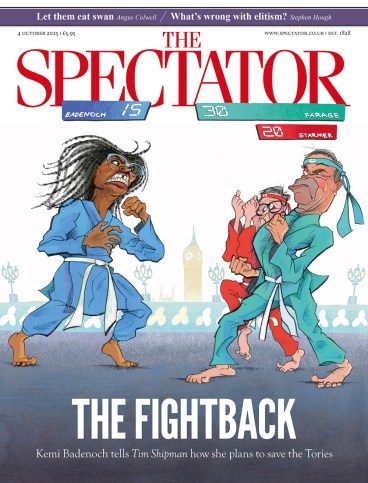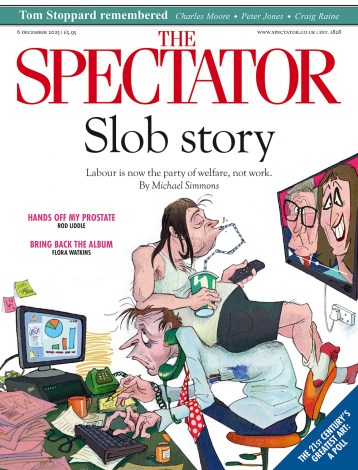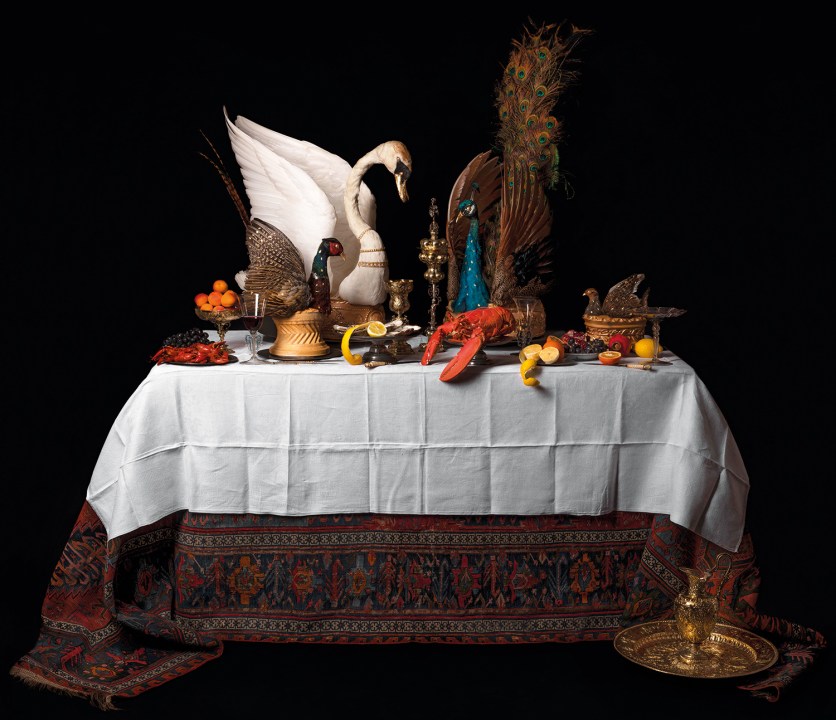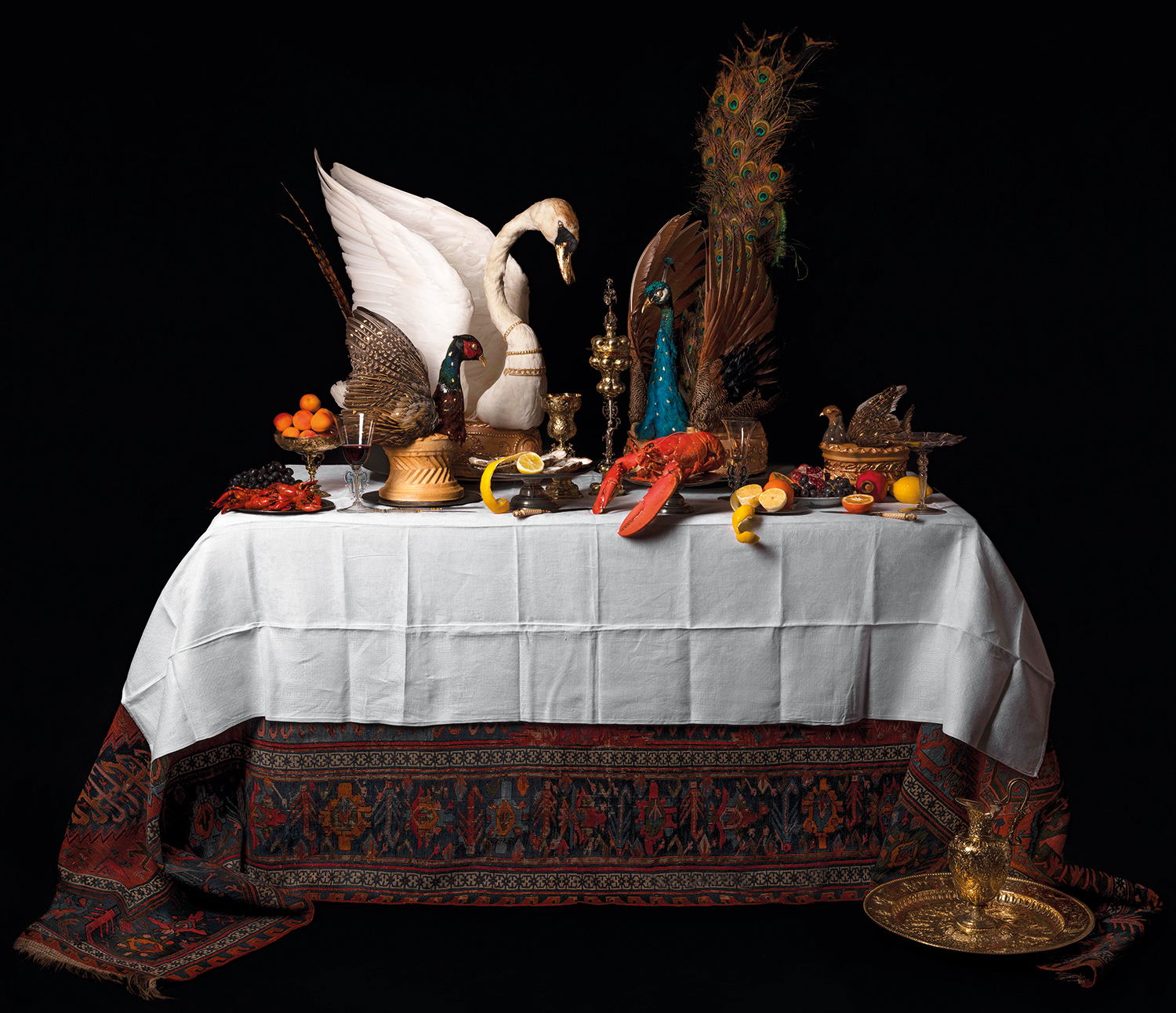
Ivan Day pulls out an old Habsburg cookbook from his library. The 300-year-old volume is so thick it’s almost a perfect cube, and by some miracle the spine remains intact as he opens it. ‘It’s like a big Harry Potter spellbook,’ he jokes while flicking through drawings of pastry baked in the shapes of dolphins, tortoises, pelicans and griffins. I recognise one design from the half-eaten pie in his kitchen: a cross between a soup tureen and an embroidered throw pillow.
Ivan is a curator, self-trained cook and Britain’s premier historian of food. Historic houses and institutions around the world – including the Museum of London, the Met, the Getty Research Institute and the Fitzwilliam – have commissioned him to recreate the madly ostentatious table settings of the past, or even to restore kitchens disused for centuries. His own home, a 16th-century farmhouse on the edge of the Lake District where he keeps his collection of historic ‘kitchenalia’, resembles a cross between these things, half-museum archive and half-National Trust property.
The kitchen is vast and dark, even in the afternoon when the sky finally clears. A massive hearth stands at one end, which Ivan uses for roasting things on a spit (although today, lunch is tomato soup and crusty bread prepared by Jill, his wife). Off to its side, he fiddles with the contraption of clockwork gears, chains and pulleys, which uses the weight of a small cannonball to rotate the spit. It begins to thump and creak as the weight descends, giving the kitchen a sense of phantom busyness.
‘My mother was a brilliant cook, and so was my grandmother, but there wasn’t anyone who could teach me what I do at all,’ he says. He learned to cook over a large open fire during the seven years he spent living on Crete as a botanist. ‘I’ve avoided the professional cheffery thing because it’s absolutely no help. What often happens is I end up advising them.’
He tells me he once cooked a meal here for Heston Blumenthal. ‘Two of the dishes are still on the menu at [Heston’s restaurant] Dinner,’ he says, including roasted pineapple ‘which is kind of a joke’. Blumenthal commissioned Patek Philippe to design a clockwork spitjack, like the one Ivan has, to roast pineapples, and pineapples only.
Ivan is slightly disdainful of molecular gastronomy – ‘it’s become a bit old hat now, a little ridiculous when you look back on it’ – but is even more so of the silliness of historical re-enactment, which he says is for ‘tourists and schoolchildren’. Some might see Ivan’s work as a form of re-enactment, but really it veers towards something between scholarship and art. Now 75, he has spent more than 50 years not only studying but also practising historic cooking methods, often using the very tools that belonged to the past’s great cooks and confectioners. He believes that if you’re going to teach how people dined in the past, whether in a museum or a cooking demo, you can’t do it using ‘props’. These tools, even more so than recipes, determine what we eat and what it looks like on the table.
Sugar was sought as a sweetener or preservative, as a medicine and, most importantly, as an artistic medium
Ivan’s field has not always been taken seriously. ‘The National Trust has got much better, but often they did things which were desecration,’ Ivan says. Kitchens in many Trust houses were turned into tea rooms, storage areas or offices. ‘They were considered not to be important by the art history-trained staff, who would think, “Oh, that was just for servants”, because often some of them were brought up in places like that. They thought people wouldn’t be interested.’
Now, if the study of food history is dismissed, it’s more often out of a kind of reverse class snobbery, as if the food cooked in stately homes and palaces is somehow tainted by the disgustingly rich people who ate it. Yet studying food history is more than an exercise of cataloguing who had too much and admonishing their aristocratic excesses – their grand dining rooms, porcelain services and silver spoons. ‘It’s a strange misunderstanding, really,’ Ivan says. ‘Europe’s culinary culture was created by the imaginations of the working-class people in the kitchens, so the story is much richer than that.’
The engines of their imaginations can be found everywhere in Ivan’s kitchen: wooden biscuit prints, silver larding pins, pewter ice-cream moulds in the shapes of cucumbers and bunches of asparagus. Two toddler-sized gingerbread moulds of Queen Mary and William of Orange (‘those belonged to Clive of India’) hang near the dining table. Brick-shaped sugar moulds from the 18th century – and modern ones that Ivan has hand-carved – lie on tables and windowsills. He has used them to create several pure white, gothic-looking ‘bowers of bliss’, made entirely of sugar.
At the mention of sugar, Ivan slips into the mode of an academic. The earliest written record of sugar, he tells me, appeared in a 1st-century medical treatise by the Greek botanist Dioscorides, who recommended sugar mixed with water as an aid for a painful bladder and kidneys. Its name comes from Sanskrit, via the Arabic word zukka, as sugar was cultivated throughout the Islamic world and exported beyond. It was sought as a sweetener or preservative, as a medicine and, most importantly, as an artistic medium.
The sugar statues were symbolic. They tell a story, and it’s often a political story
Sugar sculptures made their way on to the tables of Europe’s rich and powerful via trade with the Ottoman Empire, where they were used in processions and feasts for the sultan. The hardened product of sugar and tragacanth gum was as fine as porcelain. In fact, in the 18th century, Meissen and Sèvres modelled their early work on that of confectioners. Their porcelain served as more permanent versions of sugar statues that had been made for lavish banquets.
Were these sculptures purely decorative? They weren’t typically eaten, Ivan says, but to describe them as just decorative slightly misses the point. ‘They were symbolic. They tell a story,’ he says, ‘and it’s often a political story.’ For example, one dinner arranged between James II and Pope Innocent XI had a six-foot sugar centrepiece depicting the triumph of Catholicism over Protestantism. James had wanted Rome’s support in a war against the Dutch. The Pope, believing there were more important things to do than wage war against other Christians, refused to show up.
That a sugar statue would have changed his mind is unlikely, but not implausible. It’s simply difficult for me to imagine, with my modern notions of sugar as ephemeral and cheap, dissolving into my tea or coffee at fractions of a penny per spoonful. Even sugar’s taste has been tarnished by its availability: sickly-sweetness has come to be considered too unsubtle, too unsophisticated, low-class. It’s like trying to imagine being wined and dined over a chocolate fountain and fondue. Hardly fashionable now. But once, it was really something special.
As if trying to further estrange me from the past, Ivan shows me a stuffed-peacock pie topper. In the early modern period, a ‘hackle’, or a taxidermised bird, might crown a pie containing its meat. I suppose I shouldn’t be any more squeamish about looking at a dead bird than about eating it, but doing both at once feels purposefully depraved. The hackle’s eyes and beak would be gilded, and golden spots were often painted on its feathers. Some, as in the gluttonous feast in Brueghel the Elder’s ‘Taste, Hearing and Touch’ (c.1620), wore rings of gold around their necks. A Belgian tapestry at Cesky Krumlov, a Habsburg castle in the Czech Republic which Ivan has been helping to restore, depicts a hackle with a peacock’s head sewn on to the body of a swan.
The Cesky Krumlov project is what Ivan calls his swan song, after which he plans to retire. The kitchen of the estate’s rococo pleasure house has a ‘flying table’, which lifts into the dining room on a pulley system. It’s one of only about a dozen or so in Europe and was designed so that the family could be served without seeing, or having their conversations heard by, the servants.
Ivan has spent the past couple of years researching the kitchen’s original set-up and mentoring a team of artisans doing the restoration work. They recently got the kitchen into basic working order, enough at least for Ivan to teach cooks how to use it and how to dress the table. There’s still work to be done, but by next year he hopes to open the palace to the public. ‘The main thing really is allowing these spaces to tell the story, and to do it in a way that doesn’t patronise people,’ though with a certain archness he says: ‘They’ll probably end up having a few re-enactors in there.’









Comments